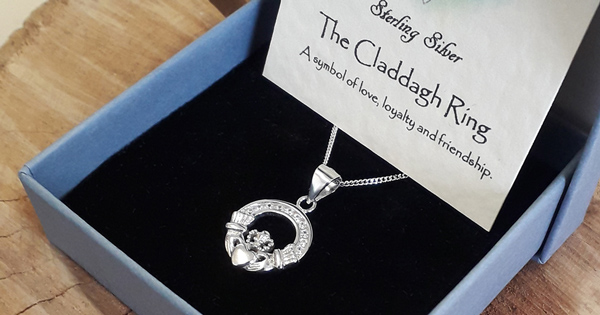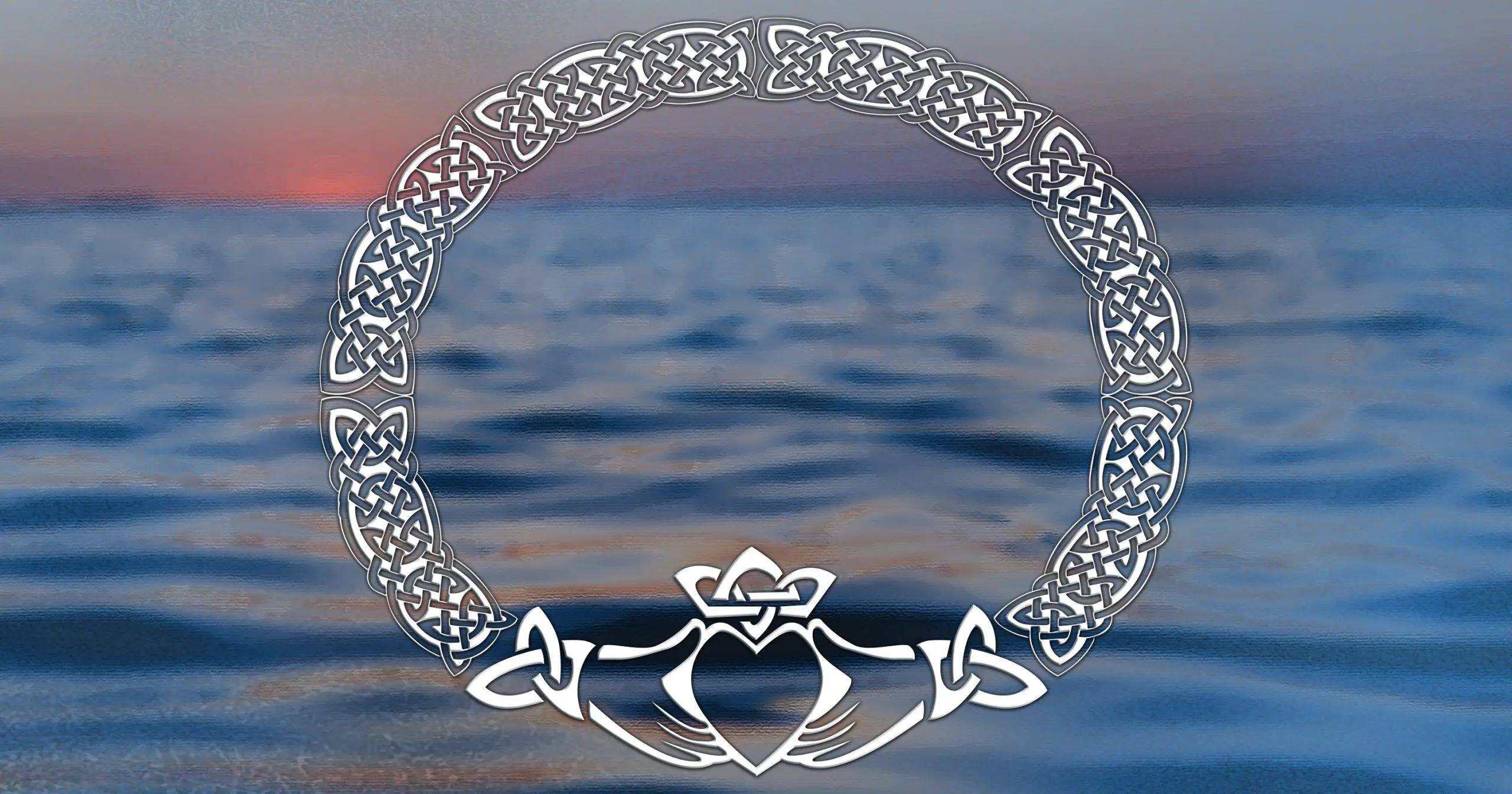The Claddagh ring, which depicts two hands cradling a heart topped by a crown, has become an enduring symbol of Irish culture. Its origins can be traced back to the ancient fishing village of Claddagh in Galway, Ireland. Over the years, this traditional Irish ring has gained widespread popularity the world over, often used as a wedding ring by men and women with Irish heritage.
A symbol of cultural identity

The history of the ring can be traced back to the 17th century. The small fishing village of Claddagh, located just outside Galway City where the River Corrib runs into Galway Bay, became the birthplace of this iconic ring. It dates back to at least the 5th century and people still live and work there today.
Claddagh rings weren’t widely known outside Galway until waves of Irish emigration during the 18th and 19th centuries brought them to distant shores. As Irish communities formed in various parts of the world, the ring became a cherished symbol of Irish heritage and a way to maintain a connection to their homeland.
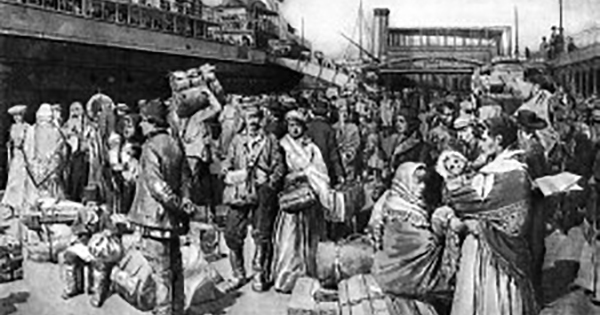
Celtic Revival

In the late 19th and early 20th centuries, a revival of interest in Irish culture and traditions emerged. The Celtic Revival was fueled by a growing sense of nationalism and a desire to break free from the cultural dominance of the British Empire.
Irish writers and artists sought to revive and celebrate Ireland’s ancient Celtic heritage, which had been suppressed and marginalised during centuries of British rule. The movement was inspired by pre-Christian Celtic mythology, folklore, and Gaelic language, seeking to reconnect with Ireland’s cultural identity.
This cultural rebirth played a significant role in the renewed popularity of the Claddagh ring. Irish writers, artists, and nationalists celebrated the ring as a symbol of Irish identity.
For many people with Irish heritage, the Claddagh ring is a powerful symbol of their cultural identity. It serves as a link to Ireland’s rich history and traditions, allowing wearers to showcase their pride and connection to their roots.
The stories and legends surrounding its creation have been passed down through generations.
Claddagh Ring meaning and symbolism

The Claddagh ring is widely used as an alternative to traditional engagement or wedding rings, carrying the weight of Irish heritage and symbolising love, loyalty, and friendship in union.
The distinct features of the Claddagh ring hold profound symbolism. Each element represents a pillar of human relationships and virtues:
The Heart: At the centre of the Claddagh ring lies the heart, symbolising love. It represents the deep affection and emotional connection shared between individuals. The heart signifies both romantic love and the love between friends and family.
The Hands: The two hands cradling the heart embody friendship. They serve as a reminder of the importance of trust, support, and camaraderie in our relationships. The hands signify the willingness to lend a helping hand and the bond that exists between two people.
The Crown: Adorning the heart, the crown symbolises loyalty and fidelity. It signifies the value of commitment, faithfulness, and the strength to withstand the tests of time. The crown embodies the loyalty that binds individuals together in friendship and love.
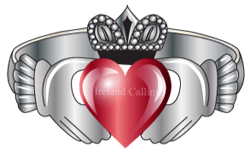
Origins of the Claddagh Ring – myths and facts
Most Irish jewellery takes its inspiration from Celtic designs such as the Celtic cross, the Tara brooch, triquetras, triskeles etc.
By contrast, the Claddagh ring is relatively modern, dating back perhaps no more than 350 years or so. It’s known that the rings were made in the Claddagh area of Galway since the late 17th century but no one is sure who first came up with the design.
The Legend of Richard Joyce

There are, of course, several theories and stories. One of the most popular stories involves a man called Richard Joyce. He was a silversmith working in Galway in the 17th century.
He was betrothed to be married to his sweetheart but before he could marry, he had to make a trip to the West Indies on business.
Unfortunately, he was captured by pirates and taken to Algeria where he was sold into slavery. He worked for a goldsmith who turned him into a master craftsman.
According to the legend, his work was so good that the goldsmith took to him and offered to let him marry his daughter.
Reunited after 14 years
Joyce refused because he wanted to get back to his fiancé. After 14 years, he was released or managed to escape. He made his way back to Galway where his betrothed was still waiting for him.

He gave her a ring he had made for her while he was enslaved. It featured a heart clasped by two hands and topped with a crown. It became her wedding ring and went on to become widely known as the Claddagh ring, after the couple’s home town in Galway.
The story, of course, cannot be verified but we do know that the very earliest surviving Claddagh rings from the early 1700s bear Richard Joyce’s initials.
However, it should be pointed out that there are three other rings from about the same period featuring the insignia of another prominent Kinsale jeweller, Thomas Meade.
We can’t be sure whether one was copying the other, or whether they were both drawing upon an earlier tradition of ring-making in the Claddagh area.
More legends about the origin of the Claddagh ring

There are other stories about the origins of the ring but they seem very much the stuff of legend. One involved a woman called Margaret Joyce, no relation to Richard as far as we know but also from the Galway area.
Margaret is said to have inherited a large fortune from her Spanish husband (there was a thriving trade between Galway and Spain at that time).
She spent a large part of this fortune on public works in the west of Ireland. To reward her kindness, God sent an eagle to drop a Claddagh ring into her lap.
Another legend involved a young girl who fell in love with a Prince. The girl was only a serving maid and her father feared the Prince merely wanted to use her and then leave her.
The Prince allayed his fears by making a Claddagh ring and explaining the meaning of it to the father; how it symbolised his love, friendship and loyalty. The father then relented and allowed the marriage to go ahead.
The Roman Fede Ring

Legends and stories aside, the invention of the Claddagh ring may have been somewhat influenced by Roman ‘Fede rings’. While the Claddagh ring originated in Ireland and the Fede ring has its origins in ancient Rome, these two styles share common elements and a rich heritage.
The name “Fede” derives from the Italian phrase “mani in fede,” meaning “hands in faith.” This type of ring features two hands clasping each other, symbolising trust, faith, and fidelity.
The Fede ring became popular during the medieval period and was often exchanged as a symbol of betrothal or marriage. Like the Claddagh ring, the Fede ring has endured through the centuries as a cherished symbol of love and commitment.
Both the Irish Claddagh and Roman Fede rings share design elements that link them together. The most obvious is the depiction of two hands clasping or holding an object. In the Claddagh ring, the hands embrace a heart, while in the Fede ring, the hands clasp each other directly. This hand-holding motif is a powerful symbol of unity, trust, and connection between individuals.
Men’s Claddagh Rings
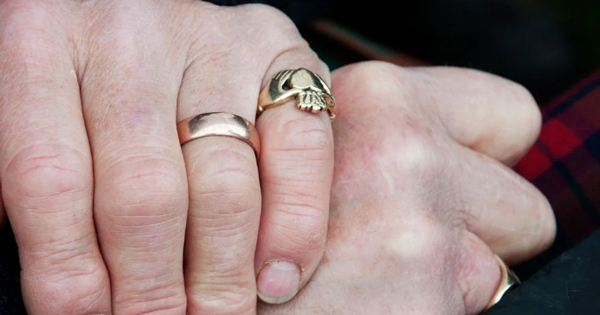
The Claddagh ring, with its rich history and profound symbolism, has long captured the hearts of both men and women. While it is often associated with women’s jewellery, it has evolved to become a popular choice for men seeking to embrace their Irish heritage or express their commitment and loyalty.
Traditionally, the Claddagh ring has held special meaning for men. It was often passed down through generations of Irish families as an heirloom, symbolizing the bond between fathers and sons. Men wore the rings to signify their loyalty and devotion to their loved ones, making it an important part of their cultural and familial identity.
Many men choose to wear a Claddagh ring to represent their romantic relationships, using it as an alternative to traditional engagement or wedding rings. The meaningful symbolism of the ring resonates with those who wish to express their devotion and fidelity in a unique and culturally significant way.
Irish Wedding Ring
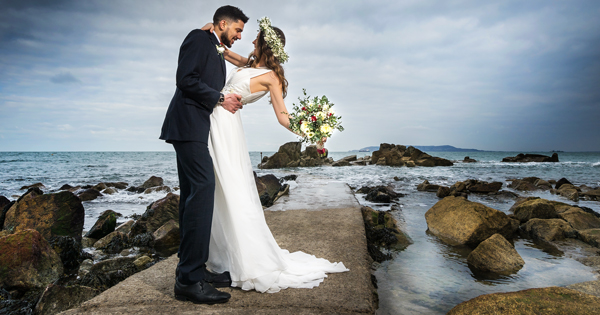
The Claddagh design and symbolism capture the essence of a strong and lasting marriage. When incorporated into a wedding or engagement ring, the Claddagh serves as a reminder of the couple’s commitment to love, support, and cherish one another throughout their journey together.
Another prevalent design in Irish wedding rings is the Trinity Knot, also known as the Triquetra. This interlacing pattern features three distinct arcs that form a continuous knot, symbolizing the eternal nature of love and unity.
Each arc represents a different aspect of a relationship: past, present, and future; love, trust, and respect; or the Holy Trinity (the Father, the Son, and the Holy Spirit). The Trinity Knot is a powerful symbol that resonates with couples who seek a ring that embodies their deep connection and commitment to one another.
Other popular designs found in Irish wedding rings include the Celtic Knot, a pattern of endless loops that represents eternity and the connection between all things; the Claddagh with Trinity Knot, which combines the symbolism of love, loyalty, friendship, and eternal unity; and the Ogham script, an ancient Irish alphabet carved into the ring, often personalized with the couple’s names or meaningful words.
Irish engagement ring
Traditionally, as a wedding ring, the Claddagh ring is worn on the left hand, with the heart pointing inward, indicating that the wearer’s heart is taken.
When engaged, the ring is flipped around so that the heart faces outward, signifying that the wearer’s heart is open to love and their commitment to their partner. This timeless tradition has made the Claddagh ring a cherished symbol of love and a popular choice for engagement rings among couples with Irish heritage or those who resonate with its profound symbolism.
In addition to the symbolic designs, Irish wedding and engagement rings are often crafted using precious metals, such as gold or silver. Gold is favoured for its timeless beauty and association with wealth and prosperity. Silver, on the other hand, is admired for its elegance and understated charm. These metals serve as a testament to the enduring nature of love and the preciousness of the commitment made between two individuals.
The Gold Claddagh Ring

Among the many variations of the Claddagh ring, the gold Claddagh ring stands out as a timeless symbol of love, loyalty, and friendship. Crafted in precious gold, this particular version of the ring holds a special place in the hearts of those who wear it. Its elegant and radiant nature adds a touch of sophistication to the rich symbolism embedded in the design, making it a cherished piece of jewellery for many.
Gold Claddagh rings come in various shades, ranging from yellow gold to white gold and even rose gold, providing individuals with a wide range of options to suit their personal preferences.
Yellow gold, with its rich and classic appearance, is a popular choice for those seeking a traditional look. White gold offers a contemporary twist, showcasing the timeless design with a modern touch. Rose gold, with its subtle blush tones, adds a touch of femininity and romance to the Claddagh ring.
The gold Claddagh ring is not only a cherished piece of jewellery but also a testament to Irish heritage and tradition. It carries with it the spirit of Ireland, the warmth of its people, and the strong bonds of friendship and loyalty that are highly valued in Irish culture.
The Irish Claddagh Ring
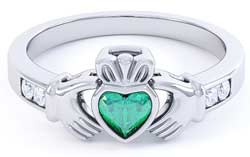
The Claddagh ring serves as a powerful reminder of the importance of love, friendship, and loyalty in our lives. The meaning and symbolism around the Claddagh ring encourage us to cherish and nurture our relationships with a sense of connection and unity.
As well as standing for these important values, the Claddagh ring holds a special place in Irish culture, representing the country’s rich heritage and traditions. It is often passed down through generations, symbolizing family bonds and Irish roots. The Claddagh ring allows people to display their cultural pride, serving as an expression of their Irish identity.
Today, the Claddagh ring continues to be cherished by women and men alike, as a symbol of love, loyalty, friendship and Irish heritage, serving as a connection to the rich tapestry of Irish culture.
Claddagh Ring FAQ
The Claddagh ring has a distinct design featuring two hands holding a heart topped with a crown. Each element of the design represents a different virtue: the hands symbolise friendship, the heart represents love, and the crown signifies loyalty.
Traditionally, a Claddagh ring is given as a gift rather than purchased for oneself. The ring is often exchanged between romantic partners as a symbol of their love and commitment. It can also be given by family members or close friends to symbolize loyalty and friendship.
There is no hard and fast rule dictating who should give it to you. Ultimately, it depends on personal preference and the meaning you attach to the ring.
No, it is not bad luck to buy yourself a Claddagh ring. Many people choose to buy themselves a Claddagh ring to celebrate their Irish heritage or simply because they appreciate the design and symbolism of the ring.
The Claddagh Ring is not associated with any specific religious denomination. It is a traditional Irish ring that originated in the fishing village of Claddagh in Galway, Ireland. It is deeply rooted in Irish culture and is appreciated by people of different backgrounds and faiths.
Absolutely! Non-Irish individuals can wear a Claddagh ring if they appreciate its design, symbolism, or connection to Irish culture. It has gained popularity worldwide and is worn by people from diverse backgrounds as a fashion accessory or as a meaningful symbol of love, friendship, and loyalty.
Wearing the Claddagh ring on the ring finger of the left hand with the heart facing outward traditionally indicates that the wearer is engaged to be married. With the heart facing inward, it symbolises that the wearer is married.
See How to wear a Claddagh Ring for more information.
Some people choose to wear the ring on different fingers, such as the middle finger or index finger, for personal preference or style. In these cases, the meaning can be more flexible. It is really up to you.
Yes, a woman can certainly give a man a Claddagh ring. There are no restrictions on who can give the ring to whom. It is a meaningful gesture that can represent love, friendship, or loyalty between two individuals, regardless of their gender or relationship status.
There is a folk legend surrounding the Claddagh ring that tells of a curse associated with it. According to the legend, if a Claddagh ring is obtained through improper means, such as by theft, it is said to bring bad luck or misfortune to the wearer. This is often referred to as the “Claddagh ring curse.”
